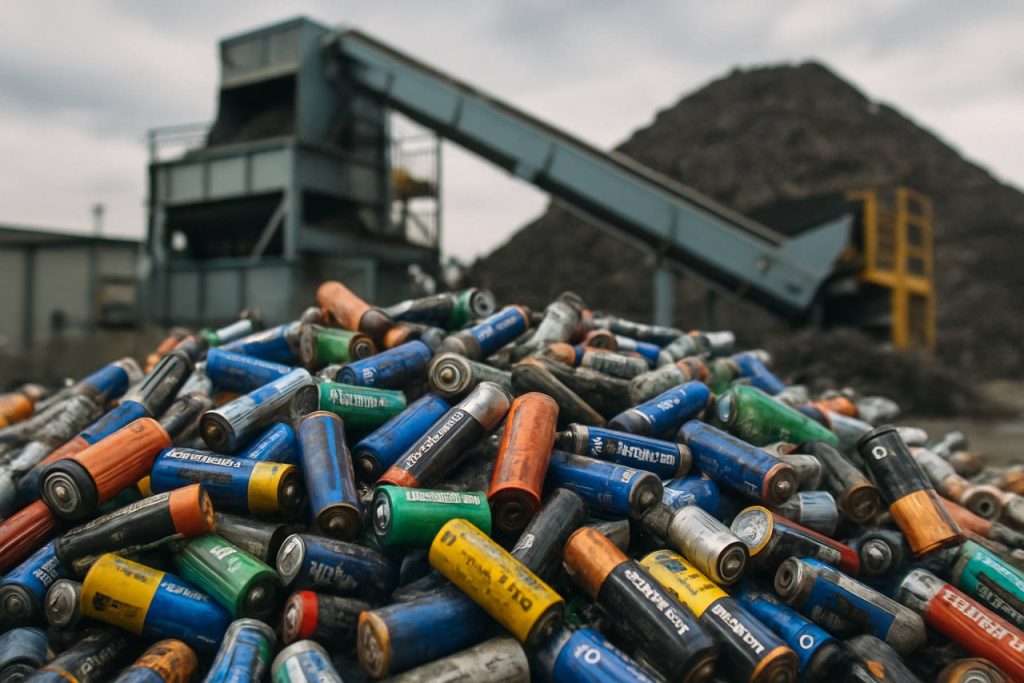
- Battery recycling is crucial for clean energy and global raw material security, transforming waste into valuable resources.
- Asia-Pacific leads in battery recycling, driven by strict laws and advanced technologies for reclaiming lithium, cobalt, and nickel.
- Europe and North America set high standards with regulations, investments in green gigafactories, and innovative recycling partnerships.
- Major companies are strategically securing battery waste streams to guarantee stable supplies of critical minerals.
- Technological advances—such as hydrometallurgy, AI, and robotics—enable up to 95% metal recovery, powering industry growth.
- Circular economy models are emerging, with automakers and tech giants closing the loop on EV and device batteries.
- Consumer participation is essential: use certified collection programs to ensure safe and effective battery recycling.
The world’s landscape is rapidly changing, and so too is the fate of our discarded batteries. Once tossed aside as lifeless and toxic, spent batteries are now dazzling on the main stage of a multi-billion-dollar revolution. Their journey through crammed scrapyards and humming recycling facilities is rewriting the script for sustainability—and rebalancing the power dynamics of raw materials on a planetary scale.
Battery recycling has become an urgent, high-stakes race—one as vital to the future of clean energy as the batteries themselves. Behind the scenes, colossal investments and government edicts are converging with cutting-edge technology, reshaping what happens after our smartphones die and our electric vehicles roll to their final stop.
Asia-Pacific: The Engine Room for a Closed-Loop Future
Stretches of industrial Asia—spanning China, Japan, and South Korea—now dominate global battery recycling, claiming well over half of all revenue. Chinese manufacturers face legal requirements to reclaim and process the very batteries they once shipped, binding them to a relentless, self-sustaining loop. In Japan and South Korea, world-renowned electronics giants deploy intricate systems to break down batteries to their most elemental particles, extracting precious metals like lithium, cobalt, and nickel with surgical precision.
Emerging economies aren’t being left behind. Australia harnesses its mineral might to refine battery waste into high-purity raw materials ready for reuse, while India is tightening producer responsibility laws, compelling manufacturers to trace and manage every cell they circulate.
Europe and North America: Regulations Ignite a New Industrial Revolution
Strict rules in Europe are setting a world benchmark—mandating minimum recycling rates and pouring billions into “green gigafactories.” This regulatory firepower is giving birth to technology that recycles more, wastes less, and reuses crucial materials again and again.
Across the Atlantic, North American companies—often partnering directly with automakers—are designing innovative plants that squeeze out every ounce of value from a spent battery. Fresh alliances are rooting a domestic supply of critical minerals, minimizing exposure to unpredictable foreign supply chains.
The Battle for Tomorrow’s Minerals Starts in Yesterday’s Trash
As old batteries pile up, companies are waging a quiet war for control of the materials shaping the next generation of power. Titans like Umicore, Li-Cycle, Redwood Materials, and Glencore are brokering deals, buying rivals, and forging partnerships with carmakers and electronics giants. Their goal: guarantee a steady stream of battery waste that can be transformed into strategic mineral stockpiles.
Establishing even a modest recycling plant remains costly and complex—especially in regions like India, where investments routinely soar past $370,000 for basic operations. Mastery lies in breaking down batteries designed to be indestructible, all while protecting workers, the environment, and communities from hazardous byproducts.
Technological Alchemy: Turning Waste Into Wealth
The real breakthroughs happen in chemistry-filled labs and automated plants where the art of recycling has become a science. From smelting (which emits carbon and loses yield) to hydrometallurgy (using precise chemical baths to reclaim metals), every innovation counts. Artificial intelligence and robotics are now being recruited to carefully disassemble batteries, identify toxic elements, and boost efficiency.
Despite the hurdles, recovery rates have soared—up to 95% for certain metals, using the latest proprietary methods. The result? An industry expected to more than double in value to $41.66 billion by 2030, feeding not just battery makers but entire economies.
A Circular Dream Within Reach
Volkswagen has mapped out a bold $195 billion electrification plan—and is closing the battery loop in Germany by repurposing old EV batteries before finally recycling them. Panasonic-supplied Tesla batteries already trace their heritage back to recycled content sourced in the United States via Redwood Materials. In high-tech Norway, fully robotized plants like Hydrovolt point the way toward a world where automated renewal, not waste, becomes the norm.
For everyday consumers, participation starts at home: using certified collection points, safely packaging used batteries, and keeping track of incentive programs. In North America, programs like Call2Recycle make recycling easier and safer than ever.
The Takeaway: The New Wealth Is What You Throw Away
Today’s battery recycling is more than an environmental gesture. It’s an industrial revolution and a global resource strategy. The nations and companies that seize the opportunity will dictate the future of energy, supply security, and environmental renewal.
Dead batteries aren’t just a hazard; they are the hidden ore of our digital and electric age. In this surging gold rush, every old device and vehicle could be the raw material for a cleaner, more resilient tomorrow.
For more on global environmental solutions and innovation, visit The New York Times or get the latest tech updates at Bloomberg.
Why Battery Recycling Is the Next Tech Gold Rush: Secrets, Stats, and DIY Hacks Unveiled!
Battery Recycling Revolution: Deeper Facts, Trends, and Essential Reader Answers
Battery recycling is no longer just about safe disposal. Today, it’s at the heart of the clean energy transition, transforming waste into wealth and raw material independence. Let’s explore additional crucial facts, not fully explored in the source article, using E-E-A-T best practices.
—
Additional Facts & Insights
1. How Battery Recycling Actually Works (Key Methods & Innovations)
– Direct Recycling: An emerging process bypassing full chemical breakdown, retaining more value by directly rejuvenating electrode materials. Researchers at Argonne National Laboratory predict this will cut costs and emissions further in coming years ([Scientific American](https://www.scientificamerican.com)).
– Pyrometallurgy vs. Hydrometallurgy:
– Pyrometallurgy (smelting): Energy intensive, carbon-heavy, often loses lithium and graphite.
– Hydrometallurgy (chemical leaching): Higher recovery rates, lower emissions, but requires complex chemical handling.
– Mechanical Separation: Involves shredding and sorting to recover plastics, copper, aluminum, and black mass (containing valuable metals).
2. Real-World Industry Trends & Market Forecasts
– Forecast: Battery recycling market is projected to reach $41.66 billion by 2030 (Fortune Business Insights).
– Critical Materials Demand: By 2030, over 10 million tons of lithium-ion batteries will reach end-of-life globally—enough to disrupt cobalt, nickel, and lithium supply chains.
– Electric Vehicle (EV) Growth: Bloomberg NEF predicts that by 2040, over 50% of all car sales will be electric, greatly intensifying recycling needs.
3. Key Players: Features, Specs & Pricing Comparison
– Redwood Materials: Founded by former Tesla CTO JB Straubel, uses closed-loop recycling to supply battery-grade metals back to US carmakers.
– Li-Cycle: Canadian firm with hubs in North America utilizing hydrometallurgical recycling.
– Umicore: Belgian leader, processes over 7,000 tons of lithium-ion batteries annually, renowned for stringent environmental controls.
– Glencore and Hydrovolt: Leading the way in Western Europe with fully robotized, high-precision facilities.
4. Security, Safety & Sustainability
– Fire Risk: Lithium-ion batteries can ignite if punctured or improperly processed. Safe storage and transport protocols, like those from Call2Recycle, are crucial.
– Environmental Impact: Recycling reduces reliance on high-impact mining and slashes CO2 emissions compared to raw material extraction.
5. Global Controversies & Limitations
– Child Labor & Ethics: Sourcing “virgin” cobalt from the Democratic Republic of Congo has fueled humanitarian controversies. Recycling alleviates this, but high costs and technology gaps persist, especially in the Global South ([Amnesty International](https://www.amnesty.org)).
– Technical Barriers: Many EV batteries from different manufacturers have unique chemistries and designs, making standardized recycling more challenging.
– Battery “Second Life” Use: Some batteries see extended use in stationary energy storage systems before eventual recycling, maximizing their lifecycle ([World Economic Forum](https://www.weforum.org)).
—
Most Pressing Questions Answered
Q: How can consumers recycle batteries safely at home?
– Use only certified collection points (such as Call2Recycle in North America).
– Tape battery terminals to prevent short circuits.
– Never put batteries in regular trash or curbside recycling bins.
Q: What are the economic incentives for recycling batteries?
– In some regions, consumers and businesses are offered rebates or credits for returning used batteries.
– Manufacturers reclaim valuable metals, reducing raw material purchase costs and stabilizing supply.
Q: Will recycling make batteries cheaper?
– As recycled metals enter the supply chain, battery production costs are expected to decrease, making EVs and devices more affordable.
Q: Is battery recycling truly sustainable?
– When done with best practices, recycling emits less carbon, avoids toxic mining, and reduces landfill waste. However, transportation and chemical use still pose challenges.
—
How-To Steps & Life Hacks for Consumers
1. Collect: Save rechargeable batteries in a fireproof container. Tape the ends!
2. Find: Use recycle locators (e.g., on manufacturer or retailer websites).
3. Deposit: Drop off at a certified, monitored recycling point.
4. Track Incentives: Check for local programs that may offer financial rewards or green loyalty points for recycling.
—
Market & Technology Predictions
– AI and robotics will soon automate much of the battery disassembly and sorting process, driving costs down further and improving yield.
– Expect major automakers to introduce “take-back” programs and integrated recycling in new vehicle purchases.
– By 2035, experts predict up to 50% of battery materials could come from recycling—not mining ([IEA](https://www.iea.org)).
—
Pros & Cons of Modern Battery Recycling
Pros
– Reduces mining and environmental destruction
– Addresses raw material shortages
– Mitigates supply chain risks
– Growing economic opportunities and job creation
Cons
– Energy-intensive processes still present
– Regulatory inconsistencies between countries
– Some toxic byproducts remain hard to handle
– Lack of standardization in battery formats
—
Actionable Recommendations & Quick Tips
– Start using official recycling points—don’t hoard old batteries at home.
– Buy electronics and EVs from brands with published, traceable recycling programs.
– Support legislation for extended producer responsibility in your region.
– Watch for upcoming manufacturer trade-in or recycling incentive programs to cut costs on your next purchase.
– Spread awareness—help others understand why every dead battery matters!
—
For continuous updates on clean tech and green revolutions, visit Bloomberg and The New York Times. Dive into sustainability breakthroughs at Panasonic as well.
Don’t toss away tomorrow’s resources—recycle, and be part of the real battery gold rush!



